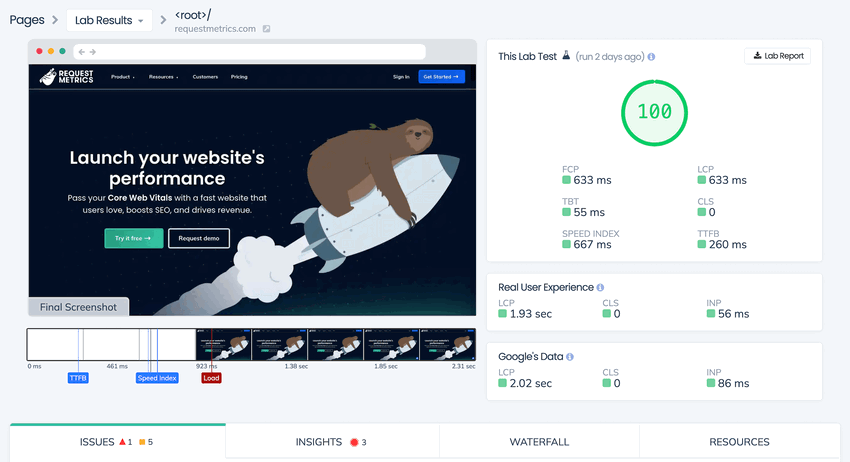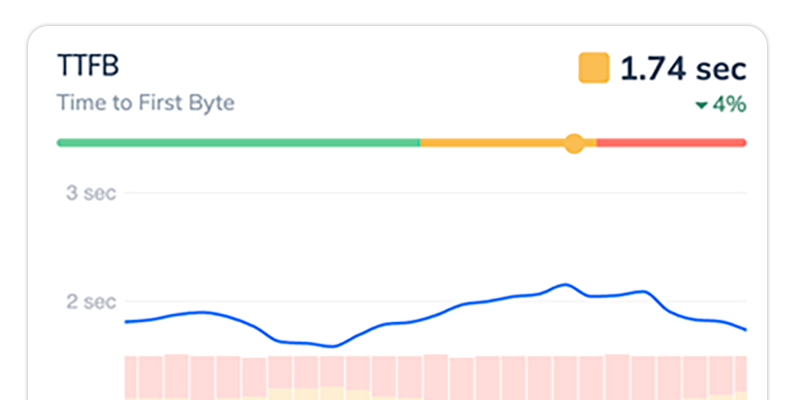Unified Web Performance: Real User Monitoring and Automatic Lighthouse Testing
Unified web performance combines Lighthouse testing and real user monitoring to boost speed, reliability, and conversions. Learn how integrated insights help you optimize your site’s performance effortlessly.

At Request Metrics, we’re always looking for ways to help you make your websites faster and your users happier. Today, we’re excited to announce a major new capability: Unified Performance Monitoring.
Request Metrics now combines the power of real-user monitoring with automated Lighthouse performance testing to get a complete picture of your website’s performance. Whether you want to see how your site performs for actual users or test pages in a controlled environment, Unified Performance Monitoring makes it easy to find and fix issues that slow your site down.
What is Unified Performance Monitoring?
Unified Performance Monitoring combines two powerful performance tools in one seamless platform:
-
Real-User Monitoring (RUM): Track Core Web Vitals and other performance metrics directly from your users’ experiences. Understand how your site performs in the real world, across all devices and locations.
-
Lighthouse Performance Testing: Run automated tests for your busiest pages every week, and get detailed, actionable recommendations. These Lighthouse-powered tests simulate user interactions, allowing you to catch issues before your users encounter them.
Even better, both RUM and Lighthouse Performance Testing work together in one unified dashboard, so you can compare synthetic test results, real-user data, and Google’s CrUX scores at a glance.

Why Does Unified Performance Matter?
Your website’s performance impacts everything from SEO rankings to user engagement and revenue. But understanding performance requires both real-world insights and proactive testing.
Get your free speed check to see your website performance for real users.
Free speed test

Real User data is the most accurate data about user experience. It’s measuring how your website performance in the hands of the people actually using it.
But RUM data can be noisy and lack substance. When a user has a bad experience, RUM data can’t always tell you why.
That’s where Lighthouse Performance Testing comes in. By testing the performance of your pages in a controlled environment, Request Metrics can provide detailed insights and recommendations to make your website faster.
Key Features of Lighthouse Performance Testing
Here’s what you can do with the new Lighthouse Performance Testing feature:
- Automated Scans: Your busiest pages are automatically tested every week on desktop and mobile.
- On-Demand Testing: Run manual tests for any page to validate fixes and changes in real time.
- Actionable Insights: Get detailed recommendations to improve Core Web Vitals like LCP, CLS, and INP, along with other key metrics.
- Side-by-Side Comparison: Compare synthetic test results with real-user data to see the complete performance story.
See Unified Performance Monitoring in Action
Want to see how it works? Check out this quick demo video where we walk you through Unified Performance Monitoring and Lighthouse Performance Testing:
How to Get Started
Unified Performance Monitoring is available now for all Request Metrics users!
To try it out:
- Log into your Request Metrics account.
- Lighthouse testing details will be visible alongside your RUM data.
- Want a fresh scan? Visit any page report to kick off a new scan. Change your device filter to switch between desktop and mobile. Drill into the metrics for any of your pages.
Not a customer yet? No problem—sign up for a free trial today and see how Unified Performance Monitoring can transform your website’s performance.
Start Monitoring Today
With Unified Performance Monitoring, you don’t have to choose between real-user insights and proactive testing. Now, you have both—together, in one powerful tool.
Ready to see how it works? 👉 Sign up for a free trial




